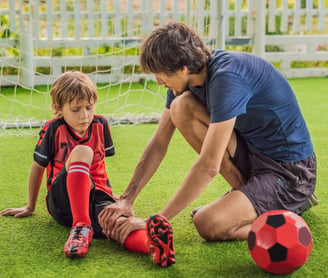How to Prevent and Treat Common Sports Injuries: A Comprehensive Guide
Discover effective strategies to prevent and treat common sports injuries with our comprehensive guide. From pre-game warm-ups and proper technique to rehabilitation exercises and self-care tips, this article provides valuable insights to keep you at the top of your game. Say goodbye to setbacks and hello to peak performance with our expert advice.
WEIGHT LOSS AND FITNESS
7/30/20233 min read


Introduction
Welcome to our comprehensive guide on how to prevent and treat common sports injuries. As avid sports enthusiasts, we understand the passion and dedication you have for your chosen athletic activities. Whether you're a professional athlete, a weekend warrior, or someone who simply enjoys staying active, injuries can be a frustrating setback. In this article, we will delve into the world of sports injuries, sharing valuable insights, preventive measures, and effective treatment approaches to help you stay on top of your game.
Understanding Common Sports Injuries
Before we dive into prevention and treatment, it's crucial to understand the most prevalent types of sports injuries. Most Common sports injuries include sprains, fractures, strains, dislocations, and tears. These can affect various parts of the body, such as the ankles, knees, shoulders, elbows, and wrists. Athletes often encounter these injuries due to overuse, improper training techniques, inadequate warm-up routines, or accidents during sporting events.
Prevention is Better Than Cure
1. Proper Warm-Up and Stretching
One of the most effective ways to prevent sports injuries is by incorporating a thorough warm-up and stretching routine before every activity. Warming up prepares your muscles, joints, and ligaments for the upcoming physical stress, reducing the risk of strains and sprains. Dynamic stretching exercises can also improve flexibility, enhancing your athletic performance.
2. Cross-Training
Engaging in cross-training, which involves varying your workout routines, is an excellent way to avoid overuse injuries. By alternating activities, you can give specific muscle groups time to recover while developing overall strength and endurance.
3. Using Proper Gear and Equipment
Appropriate sports gear, such as helmets, knee pads, and proper footwear, plays a pivotal role in injury prevention. Make sure to invest in high-quality equipment that suits your chosen sport and fits you well.
4. Listening to Your Body
Don't ignore the signals your body sends you. If you feel pain, discomfort, or fatigue during exercise, take a break. Pushing through these warning signs may exacerbate existing injuries or lead to new ones.
Effective Treatment Approaches
1. R.I.C.E Method
When injuries do occur, the R.I.C.E (Rest, Ice, Compression, Elevation) method can be a valuable first-aid approach. Rest the injured area, apply ice to reduce swelling, use compression to stabilize the injury, and elevate the affected limb to minimize inflammation.
2. Seek Professional Medical Care
For severe injuries or those that do not improve with initial first aid, it's essential to consult a medical professional promptly. A qualified healthcare provider can accurately diagnose the injury and develop a tailored treatment plan.
3. Physical Therapy
Engaging in physical therapy can be a game-changer for athletes recovering from sports injuries. A skilled therapist will guide you through rehabilitation exercises, helping you regain strength, flexibility, and mobility.
4. Pain Management
While recovering, pain management is crucial for a smooth rehabilitation process. Your healthcare provider may recommend medications or alternative therapies to alleviate discomfort and aid recovery.
Preventing Sports-Specific Injuries
Different sports come with varying risks, and understanding how to prevent injuries specific to your chosen activity is vital. Let's explore some popular sports and their injury prevention tips:
Running and Jogging
Invest in good quality running shoes that provide proper support and cushioning.
Gradually increase mileage and intensity to avoid overuse injuries.
Incorporate strength training exercises to build leg muscles and improve stability.
Basketball
Perform thorough warm-ups and stretches before hitting the court.
Focus on lateral movement exercises to enhance agility and prevent ankle injuries.
Consider wearing ankle braces for added support.
Soccer
Practice proper kicking and landing techniques to reduce the risk of knee and ankle injuries.
Strengthen core muscles to improve balance and stability during fast movements.
Tennis
Use shock-absorbent footwear to minimize stress on the knees and ankles.
Work on shoulder and arm strengthening exercises to prevent overuse injuries.
Conclusion
In conclusion, preventing and treating common sports injuries requires dedication, discipline, and a proactive approach to your well-being. By implementing the tips and techniques we've shared in this guide, you can significantly reduce the likelihood of sustaining injuries during your athletic pursuits. Remember always to listen to your body, seek professional advice when necessary, and prioritize proper warm-up and recovery practices.
Location
Nagpur, Maharashtra, India
Hours
Mon-Sat 9:00-18:00
Sun Closed
Contact
whitelanehealthcare@gmail.com


